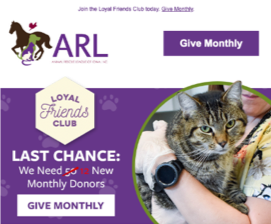News, ideas & inspiration from industry leaders

With a Little Effort, Sustainers Will Be There for You
If you’re a Gen Xer like me—ask me about my “Jenn X” license plate—then you probably spent some time in the 1990s watching a little show called “Friends.” And you probably loved seeing the cast get back together for the big reunion show last month on HBO Max.
The nostalgia flowed upon hearing the theme song from the iconic fountain-dancing opening credits. But it also got me thinking about fundraising and the valuable “friends” of animal welfare organizations.
We’re talking about your sustainer donors, the ones who sing, “I’ll be there for you” month after month. In this blog, I’ll offer up some helpful tips for building a stronger monthly gift program and show how these tips worked for another animal welfare org.
Why sustainers?
If you’re not familiar with the power of sustainer giving, then let me share a couple of quick reasons why your development team should invest in monthly donors.
First off, having a consistent, reliable source of revenue is an essential building block for any organization. We’ve seen so many companies in recent years add monthly subscription services to their business models (including the aforementioned HBO Max) because they know that this is stable revenue that doesn’t fluctuate.
That leads into the second major reason: Monthly giving helps you diversify your revenue. When unimaginable things happen—like a global pandemic that cancels all in-person events—it’s best not to have too many eggs in one basket.
A sustainer program is simply smart business. But if it were so easy, then everyone would have a ton of monthly donors, right? The truth is that building a successful monthly giving program takes time and effort.
Getting started
The most important aspect of acquiring new sustainers is to clearly outline the “why” for donors—what is your compelling case for support? This key aspect defines your core message and primary motivators that the creative then capitalizes upon in order to resonate with donors and motivate more of them to sign up for recurring monthly donations.
The sustainer offer must differ from that of a standard direct-response offer. In most cases, a focus on making a bigger impact, with a specific, urgent and tangible problem for the donor to help solve, provides a strong offer. You can begin by understanding what kinds of offers have helped organically generate sustainer relationships.
Once the strongest offer is determined, it’s time to select the audiences to serve that offer to and the channels through which to serve it.
Through a combination of first-party and third-party data, you can create a custom model that helps identify the likelihood that someone will respond to a sustainer solicitation, as their behaviors/attributes align with existing sustainer population behaviors/attributes.
Of course, that may not be an option for every organization. In that case, we recommend using RFM (recency, frequency, monetary) segmentation to reach donors.
You can use a wide mix of channels to connect with these sustainer prospects, including:
- Website
- Digital media
- Social media
- Text messaging
- Radio
- Face to face
- Telemarketing
Finding the right balance will take time and testing. For animal welfare organizations, we’ve found success in using digital channels to make this push for sustainers.
Sustainers in action
We recently worked with the Animal Rescue League of Iowa (ARL) to boost their monthly giving program, based on the successful sustainer approach of the Humane Society of the Pikes Peak Region.
Starting in September 2020, we launched a new landing page and giving levels for ARL’s Loyal Friends Club. We then spread the word with an email campaign that promoted the Loyal Friends Club, with a goal to acquire 50 new sustainers.
As I mentioned in The Association’s May 13 webinar, “Digital Revenue: Small Changes Can Make a Big Impact,” setting a goal for sustainer appeals has proven to be very successful. When compared to a similar animal welfare client’s sustainer campaign, displaying a goal to donors performed 80% better than a general ask for new sustainers.
From the launch through May 2021, ARL has seen a 32% lift in new sustaining donors when compared to the same period in the previous year. Two-thirds of the new sustainers to the Loyal Friends Club came from existing donors, so the campaign has helped both generate new donors and, more importantly, re-engage existing ones.
One final tip: Don’t suppress sustainers from regular appeals simply because they’re committed to monthly giving. This group often has higher email open rates and response rates than the general file.
If sustainer donors are acquired and stewarded properly, a sustainer program can prove essential to an organization’s long-term growth by providing a guaranteed future source of revenue.
Sustainers are some of your most loyal donors—your true friends who will be there for you and your mission.
Hopefully, these tips will help as you PIVOT! (go ahead, it’s worth the click!) toward building a stronger monthly giving program.
Learn More
Webinar recording: Digital Revenue: Small Changes Can Make a Big Impact
More from RKD: Lessons Learned from a Year of Virtual Events




